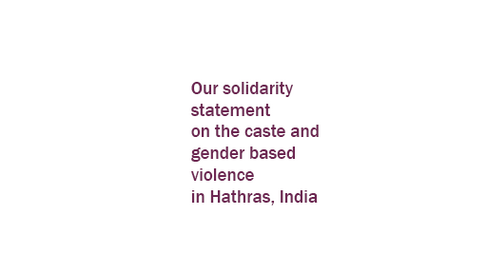
On 14th September 2020, a 19 year old woman of the Dalit Valmiki caste was gangraped and mutilated by four men of the upper Thakur caste in a village named Hathras, in the state of Uttar Pradesh in north India. She was left severely paralyzed and fought for her life in the hospital for two weeks before finally succumbing to death. Her body was hurriedly cremated by the UP police without the consent of the family. This horrific incident of gender- and caste-based violence, marred by procedural lapses, police complicity and impunity, as well as medical negligence, has led to a national public outcry. As protests have grown, the state has used repression to curb people’s protests for justice, while harassing the victim’s family, and even going so far as to deny that the rape even took place.
This incident is neither isolated nor exceptional. Its occurrence is directly a result of the intertwined misogyny and casteism that are implicit in every institution of society. Everyday Dalit lives continue to play out in a theatre of visceral discrimination and humiliation orchestrated by powerful uppercase elites, political leaders, police and government officials. Dalits continue to be marginalized from land, exploited for their labour and shunned for their ‘lowly’ moral character. Food and touch continue to be dividing lines, marking Dalits as outsiders in the upper caste (Savarna) visions of civilized life.
It is in this context of disparate power and entrenched inequality, that we can understand what Prof. Baxi means by ‘the political apparatus of rape’: ‘Rape is a technique of terror that is used with impunity to control social mobility, stifle dissent, reassert social control, gain political control and target ‘hated’ communities.’ In recent decades Dalit assertion has grown and social movements fighting for social justice have made their presence felt in various social, cultural and political arenas. The body of the Dalit women becomes one of the sites where the terrorizing force of upper caste disciplining takes place. The message here is clear: Upper caste power and authority cannot be challenged. As the grieving mother of the victim has said, her daughter’s only ‘crime’ was to be born a Dalit.
In the wake of the Hathras incident, many angry and impassioned voices have demanded ‘on the spot’ justice through the killing, castrating or lynching of the rapists. Such bloodthirsty acts of capital punishment only empower the carceral and masculine state, and distract attention away from the larger societal structures that perpetuate such violence. Annihilation of caste is the only justice that is possible here.
As we at The GendV Project think through the various forms of violence women in India experience today, we cannot help but feel angered and aggrieved at the status of Dalit women and the violence they continue to experience. The spectacular nature of this case has awakened media attention, but such exceptionalism must not detract attention from the many forms of everyday violence, rape and murder that millions of Dalit women have endured in the past and continue to do so today. Understanding this longer history is crucial to keeping our attention attuned to the deeper problems of caste and patriarchal oppression, rather than allowing cases like Hathras being perceived as one off incidents which have quick solutions. As feminist scholars, activists and citizens our struggle against these deeper social structures must become stronger and clearer.
